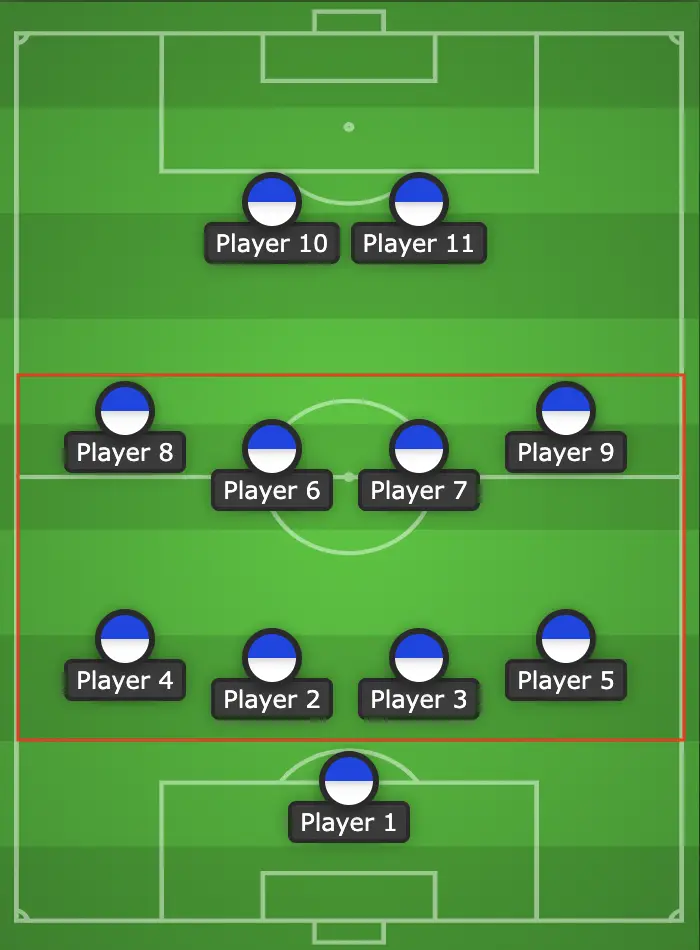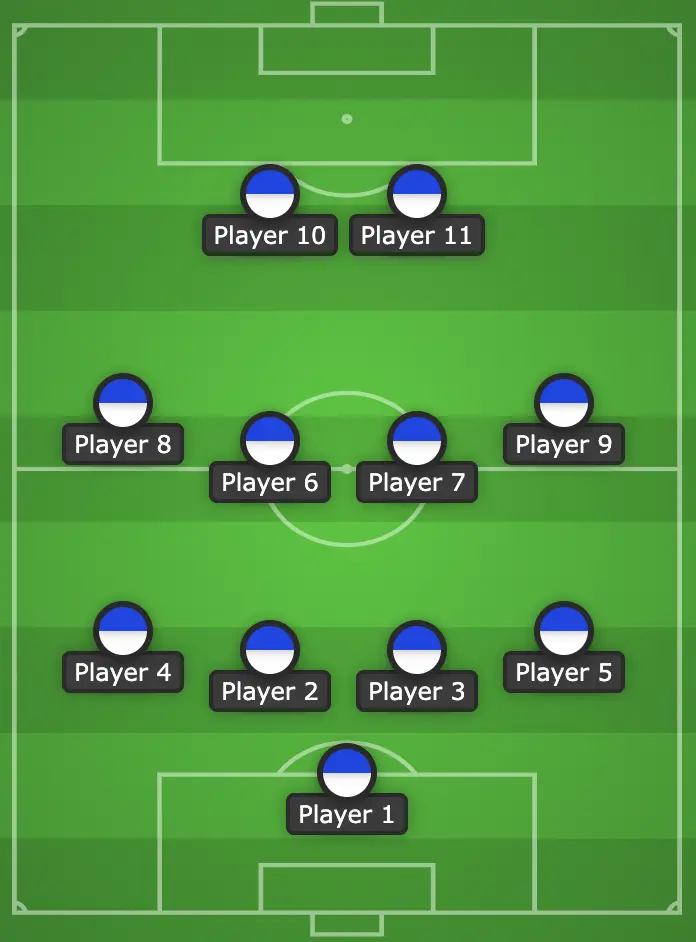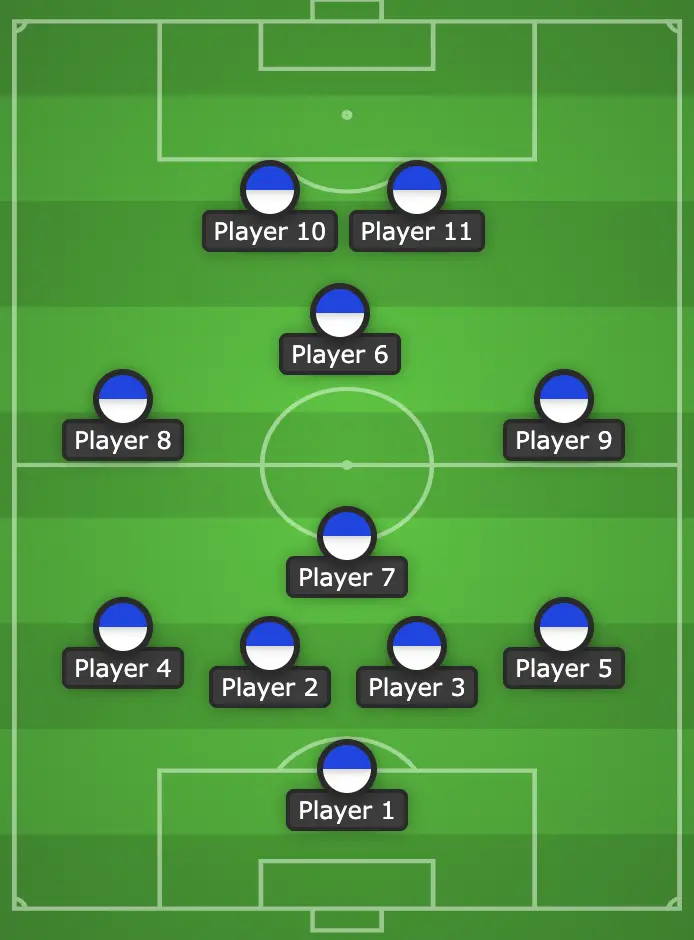Last updated on March 3rd, 2022
When you are watching a football match or playing FIFA, some of the common formations you may come across include 4-4-2 and 4-2-3-1.
Here is a guide that will show you the strengths and weaknesses of these formations and how they differ.
Contents
The Differences Between 4-4-2 and 4-2-3-1
Perfect for counterattacks, the 4-4-2 formation helps a team to execute an intensive press and quickly transition into attack when they win the ball.
The set-up is shown below:
| Defenders | 2 central defenders and 2 full-backs |
| Midfielders | 2 central midfielders and 2 wingers (RM and LM) |
| Attackers | 2 strikers |
The presence of two hardworking wingers, who play mostly from the midfield, makes the transition effective as they put in the hard work both in defence and attack.
The simplicity attached to the 4-4-2 formation makes it flexible, allowing the full-backs to join in the attack.
In contrast, the 4-2-3-1 formation is more common in this present age as compared to the 4-4-2.
The formation is set up in this way:
| Defenders | 2 central defenders and 2 full-backs |
| Midfielders | 2 holding central midfielders and 3 attacking midfielders (One No. 10 and 2 wide attacking midfielders) |
| Attackers | 1 striker |
The four defenders provide the team with width, allowing the two holding midfielders to cover the space in front of them.
This gives the attacking midfielders enough space to showcase what they can do with the ball, thus creating chances for the striker.
The two wide midfielders are vital for this formation to thrive because they tend to run into the box or cut inside, providing spaces for the two full-backs to join in the attack.
History of the two formations- 4-4-2 vs 4-2-3-1
Football continues to evolve, and while it seems that the 4-4-2 formation is no longer in common, some football teams are still using it.
The 4-4-2 formation is an English football formation, and it goes back to 1966 when England won the World Cup under Alf Ramsey. While the formation did not become popular until then, it was Viktor Maslov, a Russian that first used it several years before 1966.
Since then, the formation became dominant, and it became even more recognised thanks to former Arsenal manager Arsene Wenger.
He deployed the 4-4-2 formation when he took over the club in 1996, which eventually made his side win the Premier League unbeaten in 2004, getting them the name “The Invincibles.”
In contrast, the 4-2-3-1 is a more modern formation that came into play in the 1990s as coaches looked for ways to win the ball higher up the pitch and attack faster. Attacking faster will keep the ball from their defence, hence, conceding lesser goals.
The pioneer of the 4-2-3-1 formation is believed to be the current Atlético Nacional manager Juan Manuel Lillo. Lillo advocated it when he was at Cultural y Deportivo Leonesa in the 1992-93 campaign. After that, the formation became dominant in Spain and became even more prevalent in the last couple of decades.
Bundesliga side Bayern Munich is an example of a club that recently triumphed with the 4-2-3-1 formation in recent times, winning the UEFA Champions League in 2020 after beating Paris Saint-Germain in the final thanks to Kingsley Coman’s strike.
Differences in Defence
When comparing the differences in defence between these formations, the 4-4-2 defence seems to be more solid.
Usually, the 4-4-2 is more recognised as one of the most defensive formations.
The four defenders and four midfielders can form two walls, one in front of the box 18 and the other around the halfway line.

Moreover, the central defenders can coordinate the full-backs to keep the shape of the defence.
The defence of the 4-2-3-1 formation is more porous because the full-backs give the team the width, allowing the holding midfielders to cover the spaces in front of the central defenders.
This leaves the central defenders protected, and the full-backs can join the attacking midfielders during an attack.
However, this could sometimes leave spaces for the opponents to thrive in midfielders.
Differences in Midfield
The 4-4-2 formation lines up the midfield in two different ways:
#1 Flat 4
The four midfielders lie in front of the defence to form another wall of protection.

#2 Midfield diamond
A No. 6 stays in the base of the midfield, a defensive safeguard, and the second centre midfielder is the No. 10, who is more offensive.

The left and right midfielders stay in the space between the wings and the central midfield, technically shifting the game to the centre.
Ryan Giggs was an excellent left midfielder for Manchester United during his days.
In contrast, the two holding midfielders in the 4-2-3-1 formation is set up as a ‘double pivot.’ One of them is usually more defensive, while the other is more offensive.
You can find out more about the role of a double pivot in this article.
The more offensive player usually plays the box-to-box role by supporting the attack with defensive awareness.
The three attacking midfielders are mainly made up of a No. 10, who is flanked by two wingers.
The right-winger should usually be left-footed, while the left winger is usually right-footed. Arjen Robben and Franck Ribery played this role very well during their days at Bayern Munich.
The central attacking midfielder (No. 10) must be filled with vision and passing skills. He must also understand how to thread passes to the strikers and wingers to score goals. Mesut Ozil was excellent at this during his days at Arsenal.
Differences in Attack
In attack, two strikers line up for the attacking role for the 4-4-2 formation, with one of them being a centre forward and the other a striker.
Usually, the centre forward plays as a target man, distracting centre-backs away from the striker and other players.
Didier Drogba excelled in the centre forward role when he was at Chelsea.
However, there are moments when the second attacker is called a second striker, which was the role Dennis Bergkamp played for Arsenal in the 4-4-2 formation.
In contrast, there is usually only one striker for a 4-2-3-1 formation, with the three attacking midfielders also supporting to score goals.
Bayern Munich’s Robert Lewandowski plays this role very well, allowing him to win the 2021 FIFA The Best Award.
Indeed, Lewandowski receives the needed support, especially from a player like Thomas Muller, who has provided him with many assists.
Famous Examples of the teams that use these formations
Find below for some of the examples of teams that use the 4-4-2 and the 4-2-3-1 formations:
4-4-2
#1 Leicester City
In recent years, only a team like Leicester City predominantly use the 4-4-2 formation, especially whenever they play Kelechi Iheanacho and Jamie Vardy to pair upfront.
In fact, Leicester City won the 2015/16 Premier League with the formation. Shinji Okazaki paired Vardy at the time to complete a fairytale league triumph.
#2 Atletico Madrid
Diego Simeone led Atletico Madrid to win La Liga in the 2013/2014 season thanks to his 4-4-2 formation. They also finished runner-up in the UEFA Champions League that year.
Simeone has always been an advocate of being tight in defence.
However, he recently switched his formation from 4-4-2 to 5-3-2, which also won him the La Liga in the 2020/21 season.
#3 Manchester United
Manchester United won the Champions League in 2008 with a win over Chelsea using the 4-4-2 formation. However, the game had to go into penalties as Sir Alex Ferguson’s side secured the victory on 6-5 penalties.
If you are looking to buy the latest Manchester United merchandise, you can get it from the official Manchester United store.
4-2-3-1
#1 Bayen Munich
Bayern Munich has excelled so much with the 4-2-3-1 formation over the years, and they keep winning the Bundesliga every year. They have won the last nine Bundesliga titles largely thanks to the 4-2-3-1 formation they deploy.
It is only recently that newly appointed manager Julian Nagelsmann has shifted their formation to a 3-4-2-1 formation.
#2 Arsenal
Arsenal manager Mikel Arteta prefers the 4-2-3-1 formation to any other type of formation.
Since the beginning of the 2021/2022 season, he has permanently deployed this formation.
#3 West Ham
West Ham primarily deploys the 4-2-3-1 formation. Michail Antonio is the leading man up front, and players like Jarrod Bowen and Nikola Vlasic link up with the Jamaican from the flanks.
Verdict
Here is a summary of the differences between a 4-4-2 and a 4-2-3-1 formation:
| 4-4-2 | 4-2-3-1 | |
|---|---|---|
| Number of players in Defence | 4 | 4 |
| Number of players in midfield | 4 | 5 |
| Number of players in attack | 2 | 1 |
| Strengths | Straightforward to understand Strong sidelines Solid defence Crosses and good counterattacks | Good cover for centre backs Versatility Creative Wingers Free-flowing midfield |
| Weaknesses | Too much game in midfield Could be strenuous | No cover for full-backs Freedom for opposition centre backs |
| Famous Examples | Leicester City Atletico Madrid Manchester United | Bayern Munich Arsenal West Ham |
Both formations do have their strengths and weaknesses!
Subscribe to Telegram and Twitter to get the latest updates!

Are you passionate about football and want to earn some side income?

